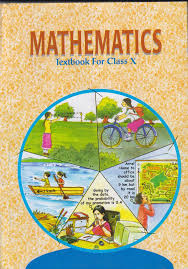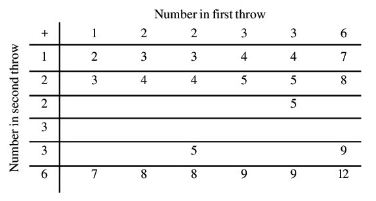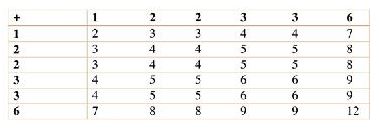Class 10 - Mathematics
Probability - Exercise 15.2

Top Block 1
Exercise 15.2
Question : 1:Two customers Shyam and Ekta are visiting a particular shop in the same week (Tuesday to Saturday).
Each is equally likely to visit the shop on any day as on another day. What is the probability that both will visit the shop on
(i) the same day? (ii) consecutive days? (iii) different days?
Answer :
There are a total of 5 days.
Shyam can go to the shop in 5 ways and Ekta can go to the shop in 5 ways.
Therefore, total number of outcomes = 5 * 5 = 25
(i) They can reach on the same day in 5 ways.
i.e., (t, t), (w, w), (th, th), (f, f), (s, s)
P (both will reach on same day)
(ii) They can reach on consecutive days in these 8 ways
i.e (t, w), (w, th), (th, f), (f, s), (w, t), (th, w), (f, th), (s, f).
Therefore, P (both will reach on consecutive days) = 5/25 = 1/5
(iii) P (both will reach on same day) = 1/5 [(From part (i)]
P (both will reach on different days) = 1 – 1/5 = 4/5
Question : 2:A die is numbered in such a way that its faces show the number 1, 2, 2, 3, 3, 6. It is thrown two times and the total score in two throws is noted.
Complete the following table which gives a few values of the total score on the two throws:
What is the probability that the total score is: (i) even? (ii) 6? (iii) at least 6?

Mddle block 1
Answer :

(i) Total times when the sum is even = 18
P(getting an even number) = 18/36 = 1/2
(ii) Total times when the sum is 6 = 4
P(getting sum as 6) = 4/26 = 1/9
(iii) Total times when the sum is at least 6 (i.e., greater than 5) = 15
P(getting sum at least 6) = 15/36 = 5/12
Question : 3:A bag contains 5 red balls and some blue balls. If the probability of drawing a blue ball is double that of a red ball,
determine the number of blue balls in the bag.
Answer :
Let us assume number of blue balls = x
Then, total number of balls = x + 5
Then;
P(red) = 5/(5 + x)
P(blue)= x/(5 + x)
According to question,
x/(5 + x) = 2 * 5/(5 + x)
⇒ x/(5 + x) = 10/(5 + x)
⇒ x(5 + x) = 10(x + 5)
⇒ 5x + x2 = 10x + 50
⇒ x2 + 5x – 10x – 50 = 0
⇒ x2 – 5x – 50 = 0
⇒ x2 -10x + 5x – 50 = 0
⇒ x(x – 10) + 5(x – 10) = 0
⇒ (x – 10)(x + 5) = 0
⇒ x = 10, -5
However, the number of balls cannot be negative.
Hence, number of blue balls = 10
Question : 4:A box contains 12 balls out of which x are black. If one ball is drawn at random from the box,
what is the probability that it will be a black ball? If 6 more black balls are put in the box,
the probability of drawing a black ball is now double of what it was before. Find x.
Answer :
Total number of balls = 12
Total number of black balls = x
P (getting a black ball) = x/12
If 6 more black balls are put in the box, then
Total number of balls = 12 + 6 = 18
Total number of black balls = x + 6
P (getting a black ball now) = (x + 6)/18
According to the condition given in the question,
2(x/12) = (x + 6)/18
⇒ 2x/12 = (x + 6)/18
⇒ 2x * 18 = 12(x + 6)
⇒ 36x = 12x + 72
⇒ 36x – 12x = 72
⇒ 24x = 72
⇒ x = 72/24
⇒ x = 3
Question : 5:A jar contains 24 marbles, some are green and others are blue. If a marble is drawn at random from the jar,
the probability that it is green is 2/3. Find the number of blue balls in the jar.
Answer :
Total number of marbles = 24
Let the total number of green marbles be x.
Then, total number of blue marbles = 24 − x
P (getting a given marble) = x/24
According to the condition given in the question,
x/24 = 2/3
⇒ 3x = 24 * 2
⇒ 3x = 48
⇒ x = 48/3
⇒ x = 16
Therefore, total number of green marbles in the jar = 16
Hence, total number of blue marbles = 24 – x = 24 − 16 = 8

